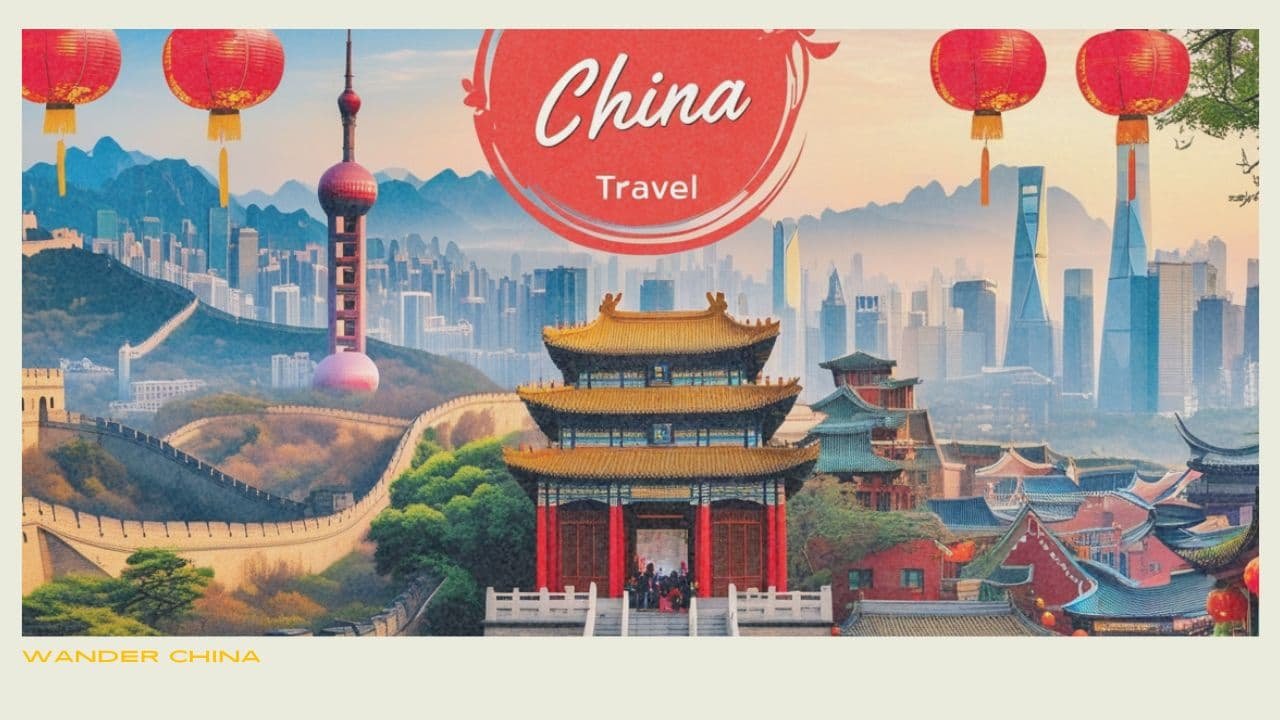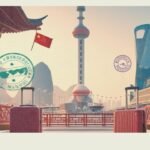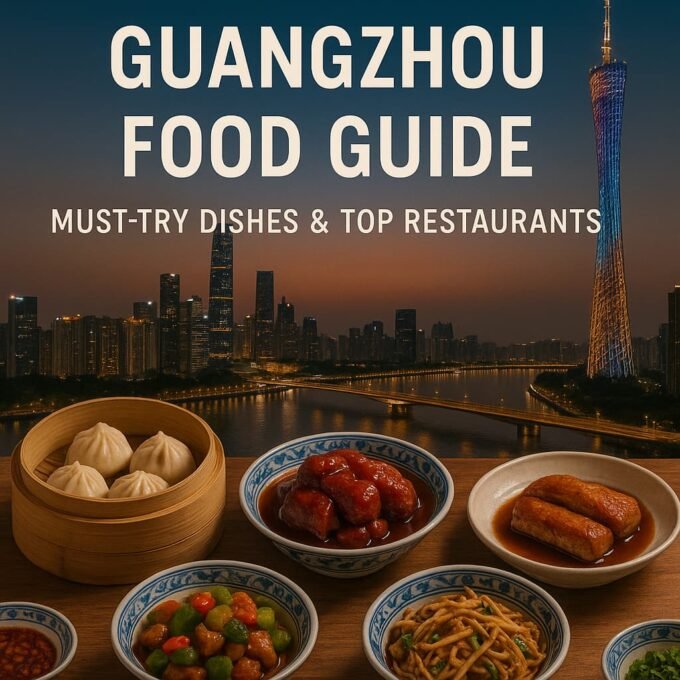A Traveler’s Guide to China’s Urban Marvels: Which City Will Steal Your Heart?
Explore China's top cities, from ancient wonders to modern marvels.

China, a land of ancient traditions and cutting-edge modernity, offers an urban tapestry unlike any other in the world. From the bustling streets of Shanghai to the historic alleyways of Beijing, the country’s cities are a testament to China’s rich cultural heritage and its rapid economic development. These urban centers serve as gateways to understanding the complexities and wonders of the world’s most populous nation.
Urban tourism in China has become increasingly significant, not just for the country’s economy, but also for cultural exchange and global understanding. Each city tells a unique story, offering visitors a chance to experience different facets of Chinese life, history, and culture. Whether you’re drawn to ancient temples, futuristic skylines, culinary adventures, or natural wonders, China’s cities have something to captivate every traveler.
In this exploration of China’s urban landscape, we’ll journey through some of the country’s most remarkable cities. From the imperial grandeur of Beijing to the picturesque canals of Suzhou, the spicy allure of Chengdu to the karst-studded horizons of Guilin, we’ll uncover what makes each destination unique. We’ll also delve into the fusion of East and West in Hong Kong, the ancient wonders of Xi’an, and the winter magic of Harbin.
As we embark on this urban adventure, prepare to be amazed by the diversity, energy, and charm of China’s cities. Each one offers a distinct flavor of this vast and varied country, promising unforgettable experiences and insights into one of the world’s oldest and most fascinating civilizations.
Beijing: The Heart of Chinese History and Culture
Beijing, the capital of China, stands as a testament to the nation’s rich history and its rapid modernization. This sprawling metropolis offers visitors an unparalleled blend of ancient wonders and contemporary marvels, making it a must-visit destination for anyone exploring China’s urban landscapes.
At the heart of Beijing’s historical allure is the iconic Great Wall of China. While not entirely within the city limits, several well-preserved sections are easily accessible from Beijing. The Mutianyu and Badaling sections are particularly popular, offering breathtaking views of the wall snaking across rugged mountain ridges. Walking along this ancient fortification provides a tangible connection to China’s imperial past and offers insight into the ingenuity of ancient Chinese engineering.
No visit to Beijing is complete without exploring the Forbidden City, the world’s largest palace complex. This vast ensemble of traditional Chinese architecture served as the imperial palace for 24 emperors during the Ming and Qing dynasties. As you wander through its myriad courtyards, halls, and gardens, you’ll be transported back in time, imagining the intrigue and opulence of imperial China. The intricate details of the palace’s design, from its golden roof tiles to its ornate dragon motifs, showcase the pinnacle of Chinese craftsmanship.
Adjacent to the Forbidden City lies Tiananmen Square, one of the world’s largest public squares and a site of immense historical and political significance. Flanked by important buildings such as the Great Hall of the People and the National Museum of China, the square serves as a central gathering place and a symbol of modern China. Watching the daily flag-raising ceremony at dawn or simply observing the bustling activity in the square offers a glimpse into contemporary Chinese life and patriotism.
For a more intimate look at traditional Beijing life, venture into the city’s hutongs. These narrow alleyways, lined with traditional courtyard homes, offer a stark contrast to the city’s modern facade. Many hutongs have been preserved or restored, allowing visitors to experience the charm of old Beijing. Take a rickshaw tour, sample local street food, or simply wander the maze-like streets to discover hidden temples, quaint shops, and local residents going about their daily lives.
While Beijing is steeped in history, it’s also a showcase of modern Chinese architecture and urban planning. The Bird’s Nest stadium and Water Cube aquatics center, built for the 2008 Olympics, stand as bold examples of contemporary design. The CBD area, with its soaring skyscrapers like the CCTV Headquarters (locally known as “big pants” due to its unique shape), demonstrates China’s economic prowess and architectural ambition.
Beijing’s ability to juxtapose the ancient with the ultra-modern makes it a fascinating city to explore. From the serene gardens of the Summer Palace to the cutting-edge galleries in the 798 Art District, the city offers a comprehensive view of China’s past, present, and future. Its role as the political and cultural capital ensures that a visit to Beijing is not just a trip to another city, but an immersion into the very essence of Chinese civilization.
Shanghai: Where East Meets West
Shanghai, the gleaming pearl of China’s eastern coast, is a city that effortlessly blends the old and the new, the East and the West. This metropolis of over 24 million people is a testament to China’s rapid modernization while still preserving pockets of its rich cultural heritage.
The Bund, Shanghai’s iconic waterfront promenade, is perhaps the best place to witness this juxtaposition. Stretching along the western bank of the Huangpu River, The Bund is lined with grand colonial-era buildings that harken back to Shanghai’s days as a thriving international port. These architectural marvels, housing banks, trading houses, and hotels, stand in stark contrast to the futuristic skyline of Pudong across the river.
Pudong, once a stretch of farmland just three decades ago, now boasts some of the world’s most impressive skyscrapers. The Oriental Pearl TV Tower, with its distinctive pink spheres, was once the tallest structure in China. Today, it’s dwarfed by the Shanghai Tower, a 632-meter behemoth that twists gracefully towards the sky. At night, the Pudong skyline transforms into a dazzling light show, reflecting off the river and creating a truly magical atmosphere.
For those seeking a taste of old Shanghai, Yu Garden in the Old City is a must-visit. This classical Chinese garden, built during the Ming Dynasty, is a maze of pavilions, rockeries, and tranquil ponds. The nearby Yuyuan Bazaar offers a glimpse into traditional Chinese architecture and bustling market life, albeit with a touristy twist.
The French Concession, a charming area once administered by the French, offers tree-lined streets, art deco villas, and a plethora of cafes and boutiques. This area is perfect for a leisurely stroll, allowing visitors to soak in the unique ambiance and perhaps stumble upon hidden gems like a vintage jazz bar or a quaint bookshop.
Shanghai’s reputation as a shopper’s paradise is well-deserved. Nanjing Road, one of the world’s busiest shopping streets, stretches for 5.5 kilometers and caters to all budgets. For luxury brands, head to Huaihai Road or the swanky malls of Xintiandi. If you’re after something more unique, explore the boutiques and designer stores in Tianzifang, a labyrinth of narrow alleys in the former French Concession.
From its towering skyscrapers to its hidden lanes, from world-class museums to street-side dumpling stalls, Shanghai offers a sensory overload that captivates and excites. It’s a city that honors its past while hurtling towards the future, making it an essential stop on any journey through China.
Xi’an: A Journey Through Ancient China
Xi’an, the ancient capital of China, stands as a testament to the country’s rich history and cultural heritage. This city, once the starting point of the legendary Silk Road, offers visitors a unique blend of ancient wonders and modern marvels.
Terracotta Army: An Eighth Wonder of the World
The Terracotta Army is undoubtedly Xi’an’s crown jewel. Discovered in 1974, this vast collection of life-sized clay soldiers, horses, and chariots was created to guard Emperor Qin Shi Huang in the afterlife. Each warrior is unique, with distinct facial features and expressions, showcasing the incredible craftsmanship of ancient Chinese artisans. Walking through the massive pits housing these silent sentinels is an awe-inspiring experience that transports visitors back to the Qin Dynasty over 2,000 years ago.
City Wall: A Magnificent Medieval Fortification
Xi’an’s City Wall, one of the oldest and best-preserved urban fortifications in China, encircles the old city center. Stretching for 14 kilometers, this massive structure offers a unique perspective on the city’s layout. Visitors can walk, cycle, or even take a golf cart around the wall, enjoying panoramic views of both the ancient and modern sections of Xi’an. The wall is particularly beautiful at night when it’s illuminated, creating a magical atmosphere that blends history with contemporary urban life.
Muslim Quarter: A Feast for the Senses
The bustling Muslim Quarter is a vibrant testament to Xi’an’s multicultural heritage. This neighborhood, home to the city’s Hui Muslim community, is a maze of narrow alleys filled with street food stalls, souvenir shops, and historic mosques. The air is thick with the aroma of sizzling meat skewers, freshly baked bread, and fragrant spices. Don’t miss the chance to sample local delicacies like roujiamo (Chinese hamburger) or yangrou paomo (flatbread in mutton stew). The Great Mosque, a unique blend of Chinese and Islamic architecture, offers a peaceful retreat from the lively streets.
Big Wild Goose Pagoda: Buddhist Legacy and Tang Dynasty Splendor
The Big Wild Goose Pagoda, an iconic symbol of Xi’an, stands as a reminder of the city’s significance in the spread of Buddhism in China. Built in 652 during the Tang Dynasty, this seven-story pagoda originally housed Buddhist sutras and figurines brought from India by the monk Xuanzang. Today, visitors can climb to the top for panoramic views of Xi’an or enjoy the beautifully landscaped grounds surrounding the pagoda. In the evening, a spectacular fountain show takes place in the North Square, combining water, music, and lights in a modern interpretation of Tang Dynasty aesthetics.
Xi’an’s ability to seamlessly blend its ancient heritage with modern development makes it a captivating destination for history enthusiasts and culture seekers alike. From the silent army guarding an emperor’s eternal rest to the lively streets echoing with centuries of trade and cultural exchange, Xi’an offers a journey through time that is unparalleled in its depth and authenticity.
Chengdu: Pandas and Sichuan Spice
Nestled in the heart of Sichuan province, Chengdu offers a unique blend of natural wonders and culinary delights that make it a must-visit destination in China. This vibrant city is perhaps best known for two things: its adorable giant pandas and its fiery Sichuan cuisine.
Panda Research Base: A Sanctuary for China’s National Treasure
No visit to Chengdu is complete without a trip to the Chengdu Research Base of Giant Panda Breeding. This world-renowned conservation center is home to over 80 pandas, offering visitors a rare opportunity to observe these endangered creatures up close. The base’s lush bamboo forests and state-of-the-art facilities provide an ideal environment for pandas to thrive. Early morning visits are recommended to catch the pandas at their most active, munching on bamboo or playfully rolling around.
Sichuan Cuisine: A Fiery Feast for the Senses
Chengdu’s culinary scene is a paradise for food lovers. Sichuan cuisine, known for its bold flavors and liberal use of spices, particularly the numbing Sichuan peppercorn, takes center stage here. Must-try dishes include the mouth-numbing mapo tofu, the fragrant kung pao chicken, and the iconic hotpot. For the brave, the “mala” (numbing and spicy) flavor profile is a unique sensation not to be missed. From street food stalls to high-end restaurants, Chengdu offers endless opportunities to explore this beloved regional cuisine.
Jinli Street: A Step Back in Time
For a taste of old Chengdu, head to Jinli Street. This bustling pedestrian street, with its traditional architecture and red lanterns, offers a glimpse into the city’s rich past. Here, you can sample local snacks, watch traditional performances, and shop for handicrafts. The street comes alive at night, with the glow of lanterns creating a magical atmosphere that transports visitors to ancient times.
Wuhou Temple: A Tribute to Ancient Heroes
History buffs shouldn’t miss the Wuhou Temple, dedicated to Zhuge Liang, a legendary military strategist from the Three Kingdoms period. The temple complex, with its tranquil gardens and intricate architecture, offers a peaceful retreat from the bustling city. The adjacent Jinli Street makes it easy to combine a visit to both attractions, immersing yourself in Chengdu’s rich cultural heritage.
Chengdu’s unique combination of natural wonders, culinary excellence, and historical sites makes it a standout destination in China. Whether you’re cooing over cute pandas, savoring spicy delicacies, or exploring ancient streets, this city offers an unforgettable experience that captures the essence of Sichuan’s charm.
Guilin: Scenic Beauty of Karst Landscapes
Nestled in the heart of Guangxi Province, Guilin stands as a testament to nature’s artistic prowess. This enchanting city is renowned for its breathtaking karst landscapes, winding rivers, and lush greenery, making it a must-visit destination for nature enthusiasts and photographers alike.
The crown jewel of Guilin’s attractions is undoubtedly the Li River cruise. This meandering waterway offers a mesmerizing journey through a landscape that seems plucked from a traditional Chinese painting. As you glide along the emerald waters, you’ll be flanked by towering limestone peaks, their reflections shimmering on the river’s surface. The mist-shrouded mountains, coupled with local fishermen on bamboo rafts, create a scene of timeless beauty that has inspired poets and artists for centuries.
No visit to Guilin is complete without witnessing the iconic Elephant Trunk Hill. This natural limestone formation, resembling an elephant dipping its trunk into the Li River, serves as the symbol of the city. The hill, with its unique shape and the water-eroded cave at its base, offers a picturesque sight, especially when illuminated at night.
For those seeking to delve beneath the surface of Guilin’s beauty, the Reed Flute Cave is an underground wonderland not to be missed. This 180-million-year-old limestone cave system is adorned with stalactites, stalagmites, and rock formations that have been artfully illuminated to create a surreal, otherworldly atmosphere. The play of light and shadow on the ancient rock formations tells a story of geological marvels spanning millennia.
Venturing slightly out of the city, the Longji Rice Terraces offer a different yet equally stunning facet of Guilin’s natural beauty. These ancient terraced fields, carved into the mountainsides by the Zhuang people over 700 years ago, present a spectacular sight that changes with the seasons. From the emerald green of spring to the golden hues of autumn, the terraces paint a living canvas that showcases the harmony between human ingenuity and nature’s grandeur.
Guilin’s unique blend of natural wonders makes it a standout destination in China. Whether you’re cruising down the Li River, marveling at the Elephant Trunk Hill, exploring the mystical Reed Flute Cave, or hiking through the Longji Rice Terraces, Guilin offers an immersive experience in some of China’s most awe-inspiring landscapes. It’s a city that not only captivates the eye but also nourishes the soul with its serene beauty and timeless charm.
Hong Kong: A Fusion of East and West
Hong Kong, a vibrant metropolis where Eastern traditions seamlessly blend with Western influences, offers visitors an unparalleled urban experience. This former British colony, now a Special Administrative Region of China, boasts a skyline that rivals any major city in the world, coupled with a rich cultural heritage that’s evident in every corner.
One of the most iconic experiences in Hong Kong is ascending Victoria Peak. As you ride the historic Peak Tram, which has been in operation since 1888, you’ll witness the city’s landscape transform before your eyes. Once at the summit, the panoramic views of the city and Victoria Harbour are simply breathtaking. The best time to visit is during sunset when the city lights begin to twinkle, creating a mesmerizing spectacle.
Across the harbor lies Tsim Sha Tsui, a bustling district that encapsulates Hong Kong’s energy. The Avenue of Stars along the waterfront pays homage to Hong Kong’s film industry, featuring statues and handprints of famous actors. As night falls, don’t miss the Symphony of Lights, a dazzling multimedia show that illuminates the harbor and surrounding skyscrapers.
For a touch of magic, Hong Kong Disneyland offers a unique blend of Disney charm and Chinese culture. While smaller than its counterparts in other countries, it compensates with its intimate atmosphere and special attractions like Mystic Manor, a ride inspired by Chinese folklore.
No visit to Hong Kong is complete without indulging in its renowned street food scene. From siu mai (pork dumplings) to egg waffles, the city’s streets are a gastronomic adventure. Venture into the narrow alleys of Mong Kok to sample local delicacies like fish balls, stinky tofu, and pineapple buns. For the more adventurous, a visit to a dai pai dong (open-air food stall) offers an authentic taste of Hong Kong’s culinary heritage.
Hong Kong’s unique position as a bridge between East and West is reflected not just in its cuisine and architecture, but also in its festivals and traditions. Witness the colorful Tin Hau Festival honoring the sea goddess, or experience the Mid-Autumn Festival when the city comes alive with lanterns and mooncakes.
Whether you’re seeking stunning views, cultural experiences, family fun, or culinary adventures, Hong Kong delivers on all fronts. Its efficient public transportation system, including the iconic Star Ferry, makes exploring this dynamic city a breeze. As you navigate through its diverse neighborhoods, from the traditional temples of Wong Tai Sin to the trendy boutiques of Causeway Bay, you’ll discover why Hong Kong truly deserves its reputation as one of the best cities to visit in China.
Hangzhou: Poetic West Lake and Tea Culture
Hangzhou, often hailed as one of China’s most beautiful cities, is a mesmerizing blend of natural splendor and cultural richness. At the heart of its allure lies the iconic West Lake, a UNESCO World Heritage site that has inspired poets, artists, and emperors for centuries.
West Lake: A Mirror of Heaven
West Lake is more than just a body of water; it’s a living canvas that changes with the seasons. Surrounded by lush hills and dotted with elegant pagodas, the lake offers a serene escape from urban life. Visitors can take leisurely boat rides, stroll along willow-lined paths, or simply sit and admire the misty landscapes that have been immortalized in countless Chinese paintings and poems.
The lake is divided into five distinct sections by the Su and Bai causeways. Each area offers its own unique charm, from the famous “Three Pools Mirroring the Moon” to the tranquil “Viewing Fish at Flower Harbor.” As you explore, you’ll understand why Marco Polo once described Hangzhou as “the finest and most splendid city in the world.”
Lingyin Temple: A Spiritual Haven
Just a short distance from West Lake, Lingyin Temple stands as one of China’s most significant and ancient Buddhist temples. Founded in 328 AD, this sprawling complex is a testament to the enduring influence of Buddhism in Chinese culture.
The temple’s name, which translates to “Temple of the Soul’s Retreat,” perfectly captures its serene atmosphere. Visitors are greeted by the sight of massive stone buddhas carved into the hillside, some dating back over a thousand years. Inside, the grand Hall of the Four Heavenly Kings and the towering statue of the Laughing Buddha offer glimpses into the rich tapestry of Chinese Buddhist art and architecture.
Longjing Tea Plantations: The Essence of Chinese Tea Culture
No visit to Hangzhou is complete without experiencing its renowned Longjing tea. The rolling hills surrounding West Lake are blanketed with terraced tea plantations, producing some of the finest green tea in the world.
A trip to the Longjing (Dragon Well) village allows visitors to walk among the tea bushes, learn about the meticulous process of tea picking and processing, and of course, sample the delicate, nutty flavor of freshly brewed Longjing tea. The experience is not just about taste, but about immersing oneself in a tradition that has been central to Chinese culture for thousands of years.
Su Causeway: A Poetic Promenade
Stretching over 2.8 kilometers across West Lake, the Su Causeway is one of Hangzhou’s most beloved attractions. Named after the famous poet Su Dongpo, who oversaw its construction during the Song Dynasty, this tree-lined causeway offers a picturesque walk through some of the lake’s most beautiful scenery.
Six bridges span the causeway, each offering unique views of the surrounding landscape. In spring, the causeway bursts into color with peach blossoms and weeping willows, while autumn brings a tapestry of golden and crimson leaves. At any time of year, a stroll along the Su Causeway feels like stepping into a traditional Chinese landscape painting.
Hangzhou’s combination of natural beauty, rich history, and cultural significance makes it a standout destination in China. Whether you’re sipping tea with a view of misty hills, exploring ancient temples, or simply losing yourself in the poetic atmosphere of West Lake, Hangzhou offers a uniquely Chinese experience that lingers in the memory long after you’ve left its shores.
Suzhou: Venice of the East
Suzhou, often referred to as the “Venice of the East,” is a city that effortlessly blends ancient charm with modern sophistication. Located in eastern China’s Jiangsu Province, this enchanting destination offers visitors a unique glimpse into traditional Chinese culture, art, and architecture.
Classical Gardens: A UNESCO World Heritage Treasure
Suzhou’s most famous attractions are undoubtedly its classical gardens, which have earned UNESCO World Heritage status. These meticulously designed landscapes are a testament to the city’s rich cultural heritage and the Chinese art of garden design. Some of the most renowned gardens include:
- The Humble Administrator’s Garden: The largest and most celebrated of Suzhou’s gardens, known for its intricate waterways and pavilions.
- Lingering Garden: Famous for its exquisite use of space and stunning rock formations.
- Master of the Nets Garden: A smaller but perfectly formed garden that showcases the essence of Ming Dynasty design.
These gardens offer visitors a serene escape from the bustling city, with their carefully arranged rocks, ponds, bridges, and traditional architecture creating a harmonious environment that reflects the Chinese philosophy of balancing man and nature.
Silk Production: A Centuries-Old Tradition
Suzhou has been renowned for its silk production for over 4,000 years, earning it the nickname “City of Silk.” The city’s silk is prized for its quality and craftsmanship, and visitors can explore this rich heritage at various locations:
- Suzhou Silk Museum: Learn about the history and process of silk production, from silkworm cultivation to weaving.
- Silk factories: Witness the intricate process of silk making and purchase high-quality silk products directly from manufacturers.
- Suzhou Silk Research Institute: Discover cutting-edge developments in silk technology and its modern applications.
Canal Tours: Exploring the City’s Waterways
Suzhou’s extensive network of canals has earned it comparisons to Venice. These ancient waterways, some dating back over 2,500 years, offer a unique perspective on the city’s history and daily life. Visitors can enjoy:
- Evening cruises along the Grand Canal, taking in the illuminated bridges and historic buildings.
- Gondola-style boat rides through smaller canals, passing under stone bridges and alongside traditional white-walled houses.
- Guided tours that combine canal cruising with visits to historic sites and local neighborhoods.
Pingjiang Road: A Step Back in Time
For those seeking to experience the atmosphere of old Suzhou, Pingjiang Road is a must-visit destination. This well-preserved historical street runs parallel to one of the city’s many canals and offers:
- Traditional architecture: Admire the distinctive black-tiled roofs and white walls of Suzhou-style buildings.
- Artisan shops: Browse stores selling traditional crafts, including embroidery, fans, and calligraphy supplies.
- Teahouses and restaurants: Sample local delicacies and enjoy a cup of famous Biluochun green tea in atmospheric settings.
- Cultural performances: Catch occasional displays of Kunqu Opera, one of the oldest forms of Chinese opera, which originated in the Suzhou area.
Suzhou’s unique blend of natural beauty, historical significance, and cultural richness makes it a standout destination for travelers seeking to experience the essence of traditional China while enjoying modern comforts. Whether you’re strolling through tranquil gardens, cruising along ancient canals, or exploring the city’s silk heritage, Suzhou offers a captivating journey through China’s past and present.
Lijiang: Naxi Culture and Yunnan Charm
Nestled in the northwestern part of Yunnan province, Lijiang is a captivating city that offers visitors a unique blend of natural beauty, rich cultural heritage, and ancient architecture. This enchanting destination is renowned for its well-preserved Old Town, breathtaking mountain scenery, and the fascinating traditions of the Naxi people.
Old Town: A Step Back in Time
Lijiang’s Old Town, also known as Dayan, is a UNESCO World Heritage site and the crown jewel of the city. As you wander through its narrow cobblestone streets and along picturesque canals, you’ll feel transported to another era. The town’s distinctive architecture features traditional Naxi-style buildings with upturned eaves and intricate wooden carvings. Don’t miss the opportunity to climb Lion Hill for a panoramic view of the Old Town’s red-tiled roofs set against the backdrop of snow-capped mountains.
Jade Dragon Snow Mountain: Nature’s Masterpiece
Rising majestically to the north of Lijiang, Jade Dragon Snow Mountain is a stunning natural wonder that dominates the skyline. This snow-capped mountain range offers a variety of activities for nature enthusiasts and adventure seekers alike. Take a cable car ride to one of the scenic viewpoints, hike through alpine meadows, or witness the impressive “Impression Lijiang” outdoor performance set against the mountain’s dramatic backdrop.
Immersing in Naxi Culture
Lijiang is the heartland of the Naxi people, one of China’s 55 recognized ethnic minorities. Their unique culture is evident throughout the city, from the distinctive traditional dress to the fascinating Dongba pictographic writing system. Visit the Dongba Culture Museum to learn about Naxi history and traditions, or attend a performance of ancient Naxi music at the Naxi Concert Hall. For a truly immersive experience, consider staying in a Naxi-style guesthouse in the Old Town.
Lugu Lake: The Kingdom of Women
A few hours’ drive from Lijiang lies the serene Lugu Lake, often referred to as the “Kingdom of Women” due to the matriarchal Mosuo culture that thrives on its shores. This pristine alpine lake, straddling the border between Yunnan and Sichuan provinces, offers a tranquil retreat from the bustle of city life. Take a boat ride on the crystal-clear waters, visit traditional Mosuo villages, or simply relax and soak in the breathtaking scenery.
Lijiang’s blend of natural wonders, living history, and unique cultural experiences make it a standout destination for travelers seeking to explore China beyond its major metropolises. Whether you’re drawn to ancient traditions, outdoor adventures, or simply the charm of a well-preserved old town, Lijiang offers a memorable journey into the heart of Yunnan’s diverse landscape and culture.
Harbin: Winter Wonderland of the North
Nestled in the northeastern province of Heilongjiang, Harbin stands out as a unique gem among China’s cities, especially during its frosty winter months. Known as the “Ice City,” Harbin transforms into a magical winter wonderland that draws visitors from around the globe.
Ice and Snow Festival
The crown jewel of Harbin’s winter attractions is undoubtedly the Harbin International Ice and Snow Sculpture Festival. Held annually from January to February, this spectacular event is the largest of its kind in the world. Massive ice sculptures, some reaching the height of small buildings, illuminate the night with colorful LED lights. Visitors can wander through intricate ice castles, slide down towering ice slides, and marvel at detailed snow carvings that showcase incredible artistic skill.
The festival spreads across several venues, with the main exhibitions at Ice and Snow World and Sun Island. Here, you’ll find recreations of famous landmarks, fantastical creatures, and abstract art pieces – all crafted from ice and snow. The sheer scale and beauty of these creations make the festival a truly unforgettable experience.
Russian Architecture
Harbin’s unique history as a Russian-influenced city is evident in its stunning architecture. In the early 20th century, the city saw an influx of Russian immigrants, leaving an indelible mark on its urban landscape. The central street, Zhongyang Dajie, is lined with baroque and byzantine style buildings that wouldn’t look out of place in St. Petersburg.
The most iconic example of this Russian influence is the Saint Sophia Cathedral. This former Russian Orthodox church, with its green onion domes and red brick facade, now serves as a museum showcasing the city’s architectural history. Walking through Harbin’s old quarter feels like stepping into a fusion of Chinese and European cultures, creating an atmosphere unlike any other Chinese city.
Siberian Tiger Park
For wildlife enthusiasts, Harbin offers a rare opportunity to see one of the world’s most magnificent predators up close. The Siberian Tiger Park, located on the north bank of the Songhua River, is home to hundreds of these endangered big cats.
This expansive park allows visitors to observe Siberian tigers in a setting that mimics their natural habitat. While the main attraction is undoubtedly the tigers, the park also houses other big cats like lions, leopards, and lynx. Visitors can tour the park in specially designed buses, ensuring a safe yet thrilling experience as these powerful creatures roam nearby.
The park plays a crucial role in tiger conservation efforts, focusing on breeding programs to help increase the population of these magnificent animals. A visit here not only provides an exciting wildlife encounter but also raises awareness about the importance of protecting these endangered species.
Harbin’s unique blend of winter festivities, European-influenced architecture, and rare wildlife experiences make it a standout destination in China. Whether you’re marveling at intricate ice sculptures, strolling down streets that echo with Russian history, or coming face-to-face with Siberian tigers, Harbin offers a city experience unlike any other in the country.
Choosing the Best City Based on Your Interests
When it comes to selecting the best city to visit in China, your personal interests and preferences play a crucial role. China’s vast landscape offers a diverse array of urban experiences, each catering to different tastes and travel styles. To help you make an informed decision, let’s categorize some of China’s most captivating cities based on common themes:
For History Buffs
- Beijing: The capital city is a treasure trove of imperial history, featuring iconic landmarks like the Forbidden City, Temple of Heaven, and the nearby Great Wall.
- Xi’an: Home to the Terracotta Army, this ancient capital offers a glimpse into China’s rich past, with its well-preserved city walls and Muslim Quarter.
For Modern Marvels
- Shanghai: A futuristic skyline, cutting-edge technology, and a vibrant contemporary art scene make Shanghai a paradise for those fascinated by modernity.
- Shenzhen: Once a fishing village, now a tech hub, Shenzhen showcases China’s rapid development and innovation.
For Nature Enthusiasts
- Guilin: Famous for its otherworldly karst landscapes, Guilin offers breathtaking natural beauty along the Li River.
- Zhangjiajie: The inspiration for the floating mountains in “Avatar,” this city provides access to stunning national parks and the world’s longest glass bridge.
For Cultural Immersion
- Chengdu: Experience Sichuan culture, spicy cuisine, and the laid-back teahouse lifestyle, not to mention the adorable pandas.
- Lijiang: Delve into the unique Naxi culture in this picturesque old town, surrounded by the dramatic landscapes of Yunnan province.
For Food Lovers
- Chengdu: Beyond pandas, it’s a UNESCO City of Gastronomy, famous for its fiery Sichuan cuisine.
- Hong Kong: A melting pot of flavors, offering everything from street food to Michelin-starred restaurants.
For Art and Literature Enthusiasts
- Hangzhou: Inspiration for countless Chinese poems and paintings, Hangzhou’s West Lake is a living canvas of natural beauty.
- Suzhou: Known for its classical gardens and silk production, Suzhou is a haven for those who appreciate traditional Chinese arts.
By aligning your choice with your interests, you’re more likely to have a fulfilling and memorable experience in China. Whether you’re drawn to ancient civilizations, futuristic cityscapes, natural wonders, or cultural experiences, there’s a Chinese city that’s perfect for you. Remember, many of these themes overlap in various cities, offering a rich, multifaceted experience wherever you choose to go.
Practical Tips for City Hopping in China
When planning to explore multiple cities in China, it’s essential to be well-prepared. Here are some practical tips to make your city-hopping adventure smoother and more enjoyable:
Transportation Options
China boasts an extensive and modern transportation network, making it relatively easy to travel between cities:
- High-Speed Trains: China’s high-speed rail system is world-class, connecting major cities with fast, comfortable, and affordable service. The network covers most of eastern and central China, with expanding routes to the west.
- Domestic Flights: For longer distances or when time is limited, domestic flights are a convenient option. China has numerous airports and a competitive airline market, often offering reasonable fares.
- Buses: For shorter distances or reaching smaller towns, long-distance buses are available. They’re usually cheaper than trains but take longer.
- Subway Systems: Most major Chinese cities have extensive and easy-to-navigate subway systems, making intra-city travel convenient and affordable.
- Taxis and Ride-Hailing Apps: Taxis are readily available in cities, and apps like Didi (China’s equivalent of Uber) are popular for convenient rides.
Visa Information
Most foreign visitors require a visa to enter China. Here’s what you need to know:
- Tourist Visa (L Visa): This is the most common visa for travelers. It’s typically valid for 30 days but can be extended in some cases.
- 72-hour and 144-hour Transit Visas: Available in certain cities, these allow visa-free stays for travelers transiting through China.
- Visa Application: Apply at a Chinese embassy or consulate in your home country. The process usually takes 4-7 working days.
- Required Documents: Typically include a passport valid for at least six months, a completed visa application form, a recent photo, and proof of round-trip air tickets and hotel reservations.
Language Considerations
While English is increasingly common in major cities, especially in the tourism industry, it’s helpful to be prepared for language barriers:
- Learn Basic Mandarin: Knowing a few key phrases can go a long way. Focus on greetings, numbers, and essential travel vocabulary.
- Translation Apps: Download apps like Google Translate or Baidu Translate. They can be lifesavers, especially for reading menus or signs.
- Written Chinese: Have important addresses and destinations written in Chinese characters. This is crucial when communicating with taxi drivers or asking for directions.
- English in Tourist Areas: Popular tourist spots, high-end hotels, and international airports often have English-speaking staff or signage.
- Body Language: Don’t underestimate the power of gestures and pointing. Chinese people are often patient with foreigners trying to communicate.
By keeping these transportation, visa, and language tips in mind, you’ll be better equipped to navigate China’s vibrant cities and make the most of your urban exploration in this vast and diverse country.
Best Times to Visit Chinese Cities
China’s vast territory encompasses diverse climates and cultural events, making the timing of your visit crucial for an optimal experience. Here’s a guide to help you plan your trip:
Seasonal Considerations
- Spring (March to May): Generally pleasant weather across most cities. Ideal for visiting places like Beijing, Xi’an, and Suzhou. Cherry blossoms bloom in many cities, creating picturesque scenes.
- Summer (June to August): Hot and humid in most cities, especially in the south. Good for visiting northern cities like Harbin or high-altitude destinations. However, it’s peak tourist season, so expect crowds.
- Autumn (September to November): Often considered the best overall season to visit China. Comfortable temperatures and clear skies in most cities. Perfect for outdoor activities and sightseeing.
- Winter (December to February): Cold in most parts, especially in the north. Ideal for winter sports enthusiasts visiting Harbin for its Ice Festival. Southern cities like Hong Kong and Guangzhou remain mild.
Festival Timings
- Chinese New Year (Late January or February): While festive, many businesses close, and transportation can be challenging. However, it’s a unique cultural experience.
- Mid-Autumn Festival (September or October): Beautiful lantern displays in cities like Hangzhou and Guangzhou.
- National Day Golden Week (First week of October): Patriotic celebrations but extremely crowded in all major tourist spots.
Avoiding Peak Tourist Seasons
- Try to avoid Chinese public holidays, especially the aforementioned Chinese New Year and National Day periods.
- Summer holidays (July-August) see an influx of domestic tourists, leading to crowded attractions and higher prices.
- For a more relaxed experience, consider visiting in the shoulder seasons of April-May or September-October.
By considering these factors, you can time your visit to Chinese cities to align with your preferences for weather, cultural experiences, and crowd levels, ensuring a more enjoyable and memorable trip.
Conclusion: The Diverse Urban Tapestry of China
China’s cities offer a kaleidoscope of experiences, each weaving its own unique thread into the country’s rich urban tapestry. From the imperial grandeur of Beijing to the futuristic skyline of Shanghai, the ancient wonders of Xi’an to the natural beauty of Guilin, every city we’ve explored presents a distinct facet of China’s multifaceted identity.
These urban centers are not just destinations; they’re gateways to understanding China’s past, present, and future. Beijing’s Forbidden City and Shanghai’s Bund stand as testaments to different eras of Chinese history. Chengdu invites you to savor its spicy cuisine and adorable pandas, while Hong Kong dazzles with its blend of Eastern and Western influences. The poetic landscapes of Hangzhou and Suzhou offer tranquil retreats, as Lijiang and Harbin showcase the diversity of China’s regional cultures and climates.
As you plan your journey through China, remember that each city is a world unto itself, waiting to be discovered. Whether you’re drawn to ancient traditions, modern marvels, culinary adventures, or natural wonders, China’s cities have something to offer every traveler.
The best city to visit in China ultimately depends on your personal interests and what you hope to experience. However, the true magic of exploring urban China lies in embracing the contrasts and connections between these diverse destinations. Each city visit will deepen your understanding and appreciation of this vast and varied country.
So pack your bags, open your mind, and prepare for an unforgettable adventure through China’s urban landscapes. From bustling metropolises to charming ancient towns, the cities of China are ready to surprise, delight, and inspire you. Your journey through this incredible country will not just be a trip, but a transformative experience that will stay with you long after you’ve returned home.
Recent Posts
- Guangzhou Garment Wholesale Markets: My Local Guide
- Best Hotel in Guangzhou: A Comprehensive Guide for Foreign Travelers
- Guangzhou Food Guide: Must-Try Dishes & Top Restaurants (2025 Edition)
- Top Outlet Malls in Guangzhou: My Ultimate 2025 Shopping Guide
- Arts and Crafts Wholesale Markets in Guangzhou
Recent Comments
Best Hotel in Guangzhou: A Comprehensive Guide for Foreign Travelers
Find the best hotels in Guangzhou—from luxury icons to local favorites. Updated...
Guangzhou Food Guide: Must-Try Dishes & Top Restaurants (2025 Edition)
I’m an expat in Guangzhou sharing the best local dishes, top restaurants...
Top Outlet Malls in Guangzhou: My Ultimate 2025 Shopping Guide
I explored Guangzhou’s best outlet malls—real deals, top brands, and local tips...
Arts and Crafts Wholesale Markets in Guangzhou
Discover Guangzhou’s top arts & crafts wholesale markets, from Yide Road to...







Leave a comment